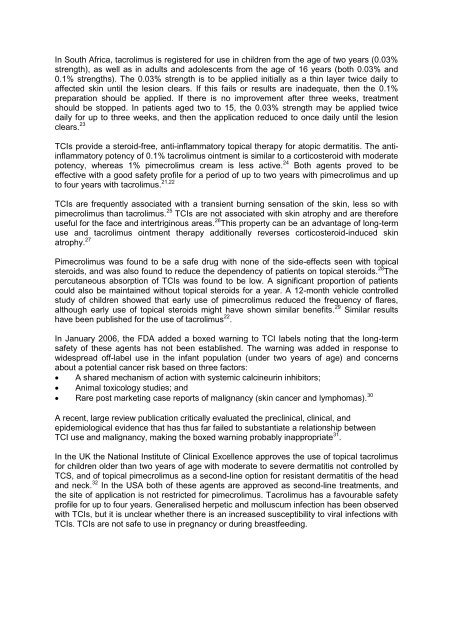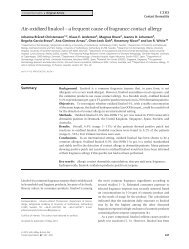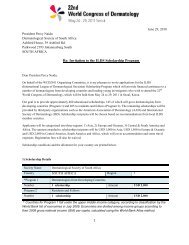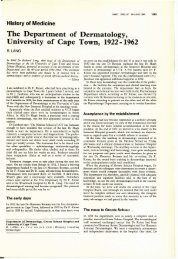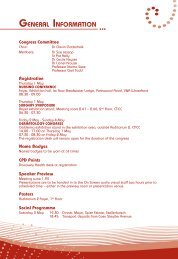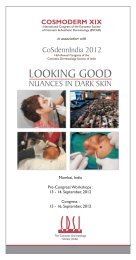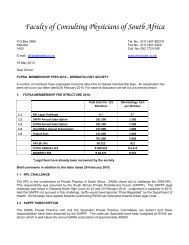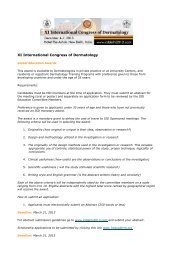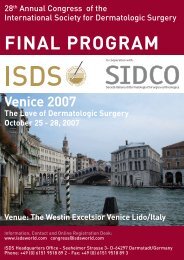Guidelines on the Management of Atopic Dermatitis ... - Dermatology
Guidelines on the Management of Atopic Dermatitis ... - Dermatology
Guidelines on the Management of Atopic Dermatitis ... - Dermatology
Create successful ePaper yourself
Turn your PDF publications into a flip-book with our unique Google optimized e-Paper software.
In South Africa, tacrolimus is registered for use in children from <strong>the</strong> age <strong>of</strong> two years (0.03%<br />
strength), as well as in adults and adolescents from <strong>the</strong> age <strong>of</strong> 16 years (both 0.03% and<br />
0.1% strengths). The 0.03% strength is to be applied initially as a thin layer twice daily to<br />
affected skin until <strong>the</strong> lesi<strong>on</strong> clears. If this fails or results are inadequate, <strong>the</strong>n <strong>the</strong> 0.1%<br />
preparati<strong>on</strong> should be applied. If <strong>the</strong>re is no improvement after three weeks, treatment<br />
should be stopped. In patients aged two to 15, <strong>the</strong> 0.03% strength may be applied twice<br />
daily for up to three weeks, and <strong>the</strong>n <strong>the</strong> applicati<strong>on</strong> reduced to <strong>on</strong>ce daily until <strong>the</strong> lesi<strong>on</strong><br />
clears. 23<br />
TCIs provide a steroid-free, anti-inflammatory topical <strong>the</strong>rapy for atopic dermatitis. The antiinflammatory<br />
potency <strong>of</strong> 0.1% tacrolimus ointment is similar to a corticosteroid with moderate<br />
potency, whereas 1% pimecrolimus cream is less active. 24 Both agents proved to be<br />
effective with a good safety pr<strong>of</strong>ile for a period <strong>of</strong> up to two years with pimecrolimus and up<br />
to four years with tacrolimus. 21,22<br />
TCIs are frequently associated with a transient burning sensati<strong>on</strong> <strong>of</strong> <strong>the</strong> skin, less so with<br />
pimecrolimus than tacrolimus. 25 TCIs are not associated with skin atrophy and are <strong>the</strong>refore<br />
useful for <strong>the</strong> face and intertriginous areas. 26 This property can be an advantage <strong>of</strong> l<strong>on</strong>g-term<br />
use and tacrolimus ointment <strong>the</strong>rapy additi<strong>on</strong>ally reverses corticosteroid-induced skin<br />
atrophy. 27<br />
Pimecrolimus was found to be a safe drug with n<strong>on</strong>e <strong>of</strong> <strong>the</strong> side-effects seen with topical<br />
steroids, and was also found to reduce <strong>the</strong> dependency <strong>of</strong> patients <strong>on</strong> topical steroids. 28 The<br />
percutaneous absorpti<strong>on</strong> <strong>of</strong> TCIs was found to be low. A significant proporti<strong>on</strong> <strong>of</strong> patients<br />
could also be maintained without topical steroids for a year. A 12-m<strong>on</strong>th vehicle c<strong>on</strong>trolled<br />
study <strong>of</strong> children showed that early use <strong>of</strong> pimecrolimus reduced <strong>the</strong> frequency <strong>of</strong> flares,<br />
although early use <strong>of</strong> topical steroids might have shown similar benefits. 29 Similar results<br />
have been published for <strong>the</strong> use <strong>of</strong> tacrolimus 22 .<br />
In January 2006, <strong>the</strong> FDA added a boxed warning to TCI labels noting that <strong>the</strong> l<strong>on</strong>g-term<br />
safety <strong>of</strong> <strong>the</strong>se agents has not been established. The warning was added in resp<strong>on</strong>se to<br />
widespread <strong>of</strong>f-label use in <strong>the</strong> infant populati<strong>on</strong> (under two years <strong>of</strong> age) and c<strong>on</strong>cerns<br />
about a potential cancer risk based <strong>on</strong> three factors:<br />
A shared mechanism <strong>of</strong> acti<strong>on</strong> with systemic calcineurin inhibitors;<br />
Animal toxicology studies; and<br />
Rare post marketing case reports <strong>of</strong> malignancy (skin cancer and lymphomas). 30<br />
A recent, large review publicati<strong>on</strong> critically evaluated <strong>the</strong> preclinical, clinical, and<br />
epidemiological evidence that has thus far failed to substantiate a relati<strong>on</strong>ship between<br />
TCI use and malignancy, making <strong>the</strong> boxed warning probably inappropriate 31 .<br />
In <strong>the</strong> UK <strong>the</strong> Nati<strong>on</strong>al Institute <strong>of</strong> Clinical Excellence approves <strong>the</strong> use <strong>of</strong> topical tacrolimus<br />
for children older than two years <strong>of</strong> age with moderate to severe dermatitis not c<strong>on</strong>trolled by<br />
TCS, and <strong>of</strong> topical pimecrolimus as a sec<strong>on</strong>d-line opti<strong>on</strong> for resistant dermatitis <strong>of</strong> <strong>the</strong> head<br />
and neck. 32 In <strong>the</strong> USA both <strong>of</strong> <strong>the</strong>se agents are approved as sec<strong>on</strong>d-line treatments, and<br />
<strong>the</strong> site <strong>of</strong> applicati<strong>on</strong> is not restricted for pimecrolimus. Tacrolimus has a favourable safety<br />
pr<strong>of</strong>ile for up to four years. Generalised herpetic and molluscum infecti<strong>on</strong> has been observed<br />
with TCIs, but it is unclear whe<strong>the</strong>r <strong>the</strong>re is an increased susceptibility to viral infecti<strong>on</strong>s with<br />
TCIs. TCIs are not safe to use in pregnancy or during breastfeeding.


